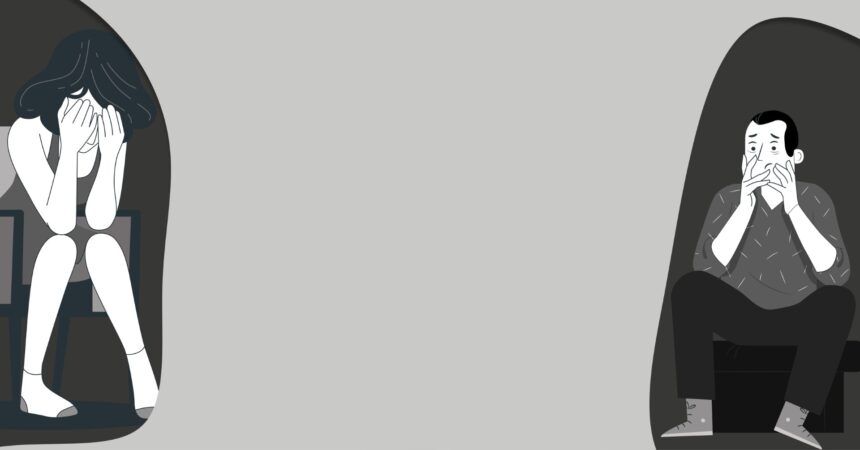We often wonder, what is it that makes us the way we are? 7 billion people and yet no one who feels like you. Generational trauma can look like the same for many and unique when compared with other people and their stories. Every being is a distinctive permutation of the colorful spectrum, darkened by the perpetual greys of their shadows. But we are all united by our pursuit of light.
In the words of Carl Jung, “The shadow is a moral problem that challenges the whole ego-personality, for no one can become conscious of the shadow without considerable moral effort. To become conscious of it involves recognizing the dark aspects of the personality as present and real. This act is the essential condition for any kind of self-knowledge.”
Sometimes, even after a great deal of introspection, your shadowed behavioral patterns are not justified. You delve deeper into your nature and nurture, and nevertheless, the picture is vague. It is not just you, but every 3 out of 5 people, who stimulate your curiosity, make you wonder that something doesn’t fit.
Let’s explore the term Generational Trauma, maybe you’ll find some answers
Intergenerational trauma (sometimes referred to as trans- or multigenerational trauma) is defined as trauma that gets passed down from those who directly experience an incident to subsequent generations. Intergenerational trauma may begin with a traumatic event affecting an individual, traumatic events affecting multiple family members, or collective trauma affecting the larger community, cultural, racial, ethnic, or other groups/populations (historical trauma)
Intergenerational trauma was first identified among the children of Holocaust survivors, but recent research has identified intergenerational trauma among other groups.
Consider some of these statistics regarding trauma:
- 1 in 7 children experienced abuse or neglect during the previous year
- Every minute, 20 people are abused physically by an intimate partner
- Approximately 10% of women develop Post Traumatic Stress Disorder sometime during their lifetime and approximately 4% of men develop PTSD during their lives
- Approximately 50% of women experience sexual violence during their lifetime
- Approximately 20% of men experience sexual violence during their lifetime
Symptoms of generational Trauma
We all, as humans, live through varying degrees of traumatic and painful experiences, that affect us mentally and physically. But scarcely are we conscious of its impact, that, not only manifests itself instantaneously but often is a cause of concern in the long term.
Symptoms of intergenerational trauma may be mistaken for other disorders and can include denial, depersonalization, isolation, memory loss, nightmares, psychic numbing, hypervigilance, substance abuse, identification with the death, unresolved grief, a sense of a shortened future, mistrust, aloofness, high anxiety, depression, panic attacks, insomnia, a sensitive fight or flight response, and issues with self-esteem and self-confidence.
Other common symptoms of intergenerational trauma may include Lack of trust in others, Anger, Irritability, Fearfulness, Inability to connect with others. It may lead to a dysfunctional immune system—one that’s either too active or not active enough.
Treatment of generational Trauma
“When we process things and understand them, we can then often find coping mechanisms. When we find coping mechanisms, we can heal, redefine ourselves. and reclaim a part of our life”
Two therapeutic approaches can be used when treating intergenerational trauma: family therapy or individual counseling. Some of the modalities of therapy to treat clients impacted by trauma are listed below.
Narrative Exposure Therapy (NET)
Narrative exposure therapy is a treatment for trauma disorders, particularly in individuals suffering from complex and multiple traumas. Often, small groups of people receive four to 10 sessions of NET together, although it can be provided individually as well. It is understood that the story a person tells himself or herself about their life influences how the person perceives their experiences and wellbeing.
With the guidance of the therapist, a patient establishes a chronological narrative of his or her life, concentrating mainly on their traumatic experiences, but also incorporating some positive events. It is believed that this contextualizes the network of cognitive, affective, and sensory memories of a patient’s trauma. By expressing the narrative, the patient fills in details of fragmentary memories and develops a coherent autobiographical story. In so doing, the memory of a traumatic episode is refined and understood. Key elements of the therapist’s behavior include empathetic understanding, active listening, therapeutic alliance, and unconditional positive regard.
The Intergenerational Trauma Treatment Model (ITM)
The Intergenerational Trauma Treatment Model (ITM) is a complex trauma treatment program for children (aged 3 to 18 years) and their caregivers. The ITM program is based on over 20 years of original research, development, and clinical practice and is informed by trauma theory, attachment theory, and advanced CBT techniques.
The ITM program offers a streamlined 21-session model, designed to eliminate waitlists for clinics. It is a self-sustaining, phase-based, and manualized program that was created by a clinical practitioner for other practitioners
Throughout treatment, caregivers enter a process that identifies and resolves their core negative self-belief, most often established in childhood. The model uses advanced Cognitive Behavioral Therapy (CBT) to effect gradual and sustained change in the thoughts, feelings, and actions informed by negative self-beliefs.
Trauma-Focused Cognitive Behavioral Therapy (TF-CBT)
TF-CBT is an evidence-based treatment modality for children and adolescents who have symptoms related to trauma. This method of treatment combines psychoeducation and cognitive techniques to teach children and adolescents how to express themselves, learn cognitive coping skills to deal with stressors, develop relaxation techniques, create and process trauma narratives, and manage behaviors that could be detrimental to their overall mental health. The timeline for this treatment typically varies from 8-25 sessions.
Breaking free from the agonizing chains of generational trauma and mitigating the shadows of our past is our right and responsibility, as much as any freedom is our truth and reality. But interestingly it is a choice, an ambiguity. Every remedy is rendered insignificant unless the knowledge becomes a knowing at the core, and the information becomes an authentic transformation.





